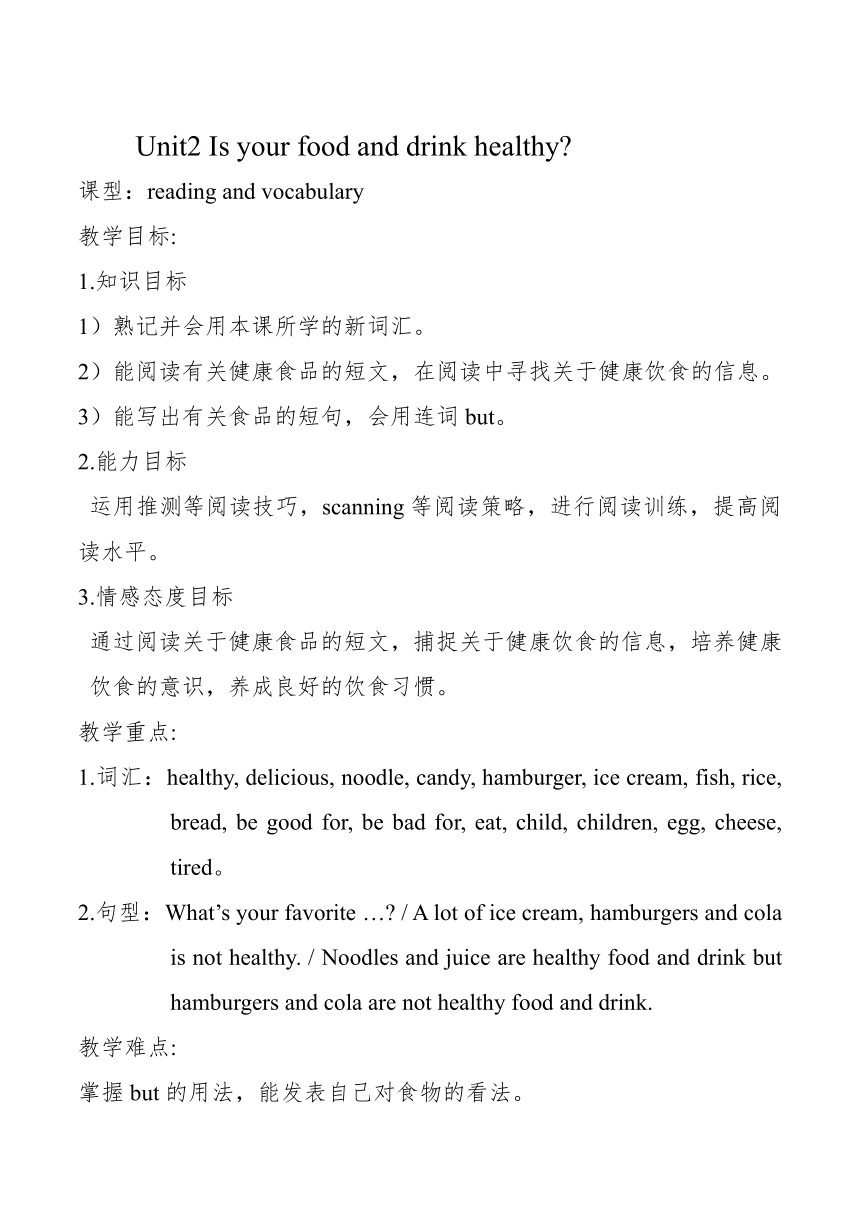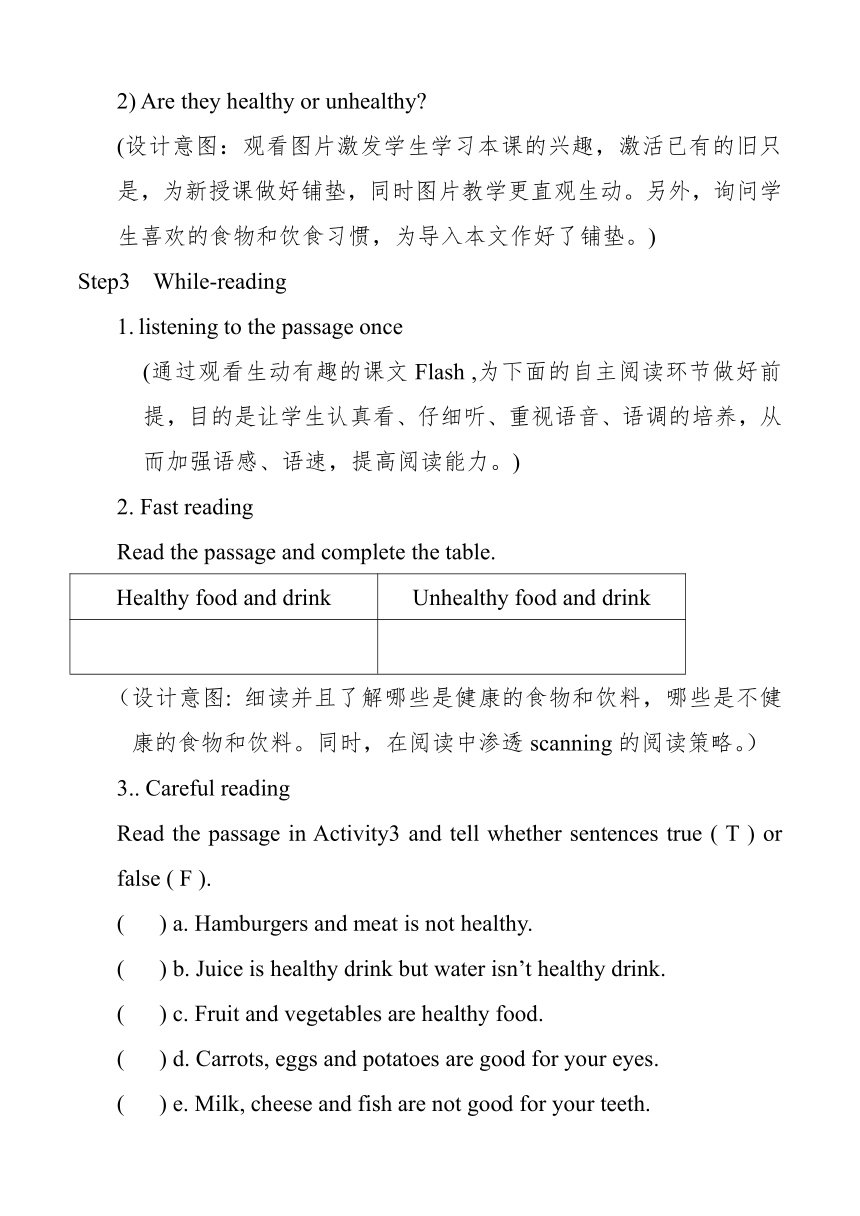外研版七上:Module 4 unit2 Is your food and drink healthy?. 教案
文档属性
| 名称 | 外研版七上:Module 4 unit2 Is your food and drink healthy?. 教案 |  | |
| 格式 | doc | ||
| 文件大小 | 137.5KB | ||
| 资源类型 | 教案 | ||
| 版本资源 | 外研版 | ||
| 科目 | 英语 | ||
| 更新时间 | 2020-09-25 08:58:20 | ||
图片预览



文档简介
Unit2 Is your food and drink healthy?
课型:reading and vocabulary
教学目标:
1.知识目标
1)熟记并会用本课所学的新词汇。
2)能阅读有关健康食品的短文,在阅读中寻找关于健康饮食的信息。
3)能写出有关食品的短句,会用连词but。
2.能力目标
运用推测等阅读技巧,scanning等阅读策略,进行阅读训练,提高阅读水平。
3.情感态度目标
通过阅读关于健康食品的短文,捕捉关于健康饮食的信息,培养健康饮食的意识,养成良好的饮食习惯。
教学重点:
1.词汇:healthy, delicious, noodle, candy, hamburger, ice cream, fish, rice, bread, be good for, be bad for, eat, child, children, egg, cheese, tired。
2.句型:What’s your favorite …? / A lot of ice cream, hamburgers and cola is not healthy. / Noodles and juice are healthy food and drink but hamburgers and cola are not healthy food and drink.
教学难点:
掌握but的用法,能发表自己对食物的看法。
教学方法:
小组合作学习、任务型教学法、情景引导学习法
教学过程:
Step1 Revision
用PPT呈现图片复习Unit1的词汇,同时引出“……is/isn’t good for health.”的句型
1. These are fruits/vegetables/drinks/meat.
2. Fruit/Vegetables is/are good for health.
3. Meat is healthy, but too much meat is not good for children.
4. Drink juice, water, tea and milk, not cola.
(设计意图:通过复习前一课所学的知识引出新知识的教学,以旧引新。)
Step2 Pre-reading
1. Think of six words for food and drink. Make three lists, and then answer the following questions.
1) What’s your favorite food and drink?
2) What’s your healthy food and drink?
3) What’s your delicious food and drink?
2. Label the pictures with the words and expression from the box.
1) 在PPT上呈现图片,然后要学生填写课本中词图配对
2)并用drink,eat与所填词汇搭配。
3. Look and say
1) Are these you favorite food and drink?
2) Are they healthy or unhealthy?
(设计意图:观看图片激发学生学习本课的兴趣,激活已有的旧只是,为新授课做好铺垫,同时图片教学更直观生动。另外,询问学生喜欢的食物和饮食习惯,为导入本文作好了铺垫。)
Step3 While-reading
listening to the passage once
(通过观看生动有趣的课文Flash ,为下面的自主阅读环节做好前提,目的是让学生认真看、仔细听、重视语音、语调的培养,从而加强语感、语速,提高阅读能力。)
2. Fast reading
Read the passage and complete the table.
Healthy food and drink Unhealthy food and drink
(设计意图: 细读并且了解哪些是健康的食物和饮料,哪些是不健康的食物和饮料。同时,在阅读中渗透scanning的阅读策略。)
3.. Careful reading
Read the passage in Activity3 and tell whether sentences true ( T ) or false ( F ).
( ) a. Hamburgers and meat is not healthy.
( ) b. Juice is healthy drink but water isn’t healthy drink.
( ) c. Fruit and vegetables are healthy food.
( ) d. Carrots, eggs and potatoes are good for your eyes.
( ) e. Milk, cheese and fish are not good for your teeth.
(设计意图:通过以上练习来检测学生对细节内容的把握程度,从而加深学生对课文内容的进一步理解。)
Step4 Post-reading
Group work (discussion)
This is a recipe(食谱) of the boy who's in the picture:
Breakfast: nothing.
Lunch: cola and3 hamburgers
Supper: rice, chicken, beef, ice cream
What’s wrong with the boy? 男孩出现什么问题?
What’s your advice for him? 你有何建议呢?
操作:在学生了解了什么食物是健康食物后, 把全班分成八年小组讨论图片中主人公的饮食是否合理,然后发表观点。
设计意图:设计开放性问题,在问题解决中引领学生的发散性思
维,拓展学生的思维空间,并使学生意识到自己在饮食上的问题,形成良好的饮食习惯。
Step5 Language points (PPT展示要点解释)
Step6 Practice(检测学生对本课所学新词能否灵活运用)
Complete the passage with the correct from of the words and expression from the box.
delicious fat important lots of
meal remember stay sweet tooth (pl. teeth)
A healthy breakfast is (1) __________ in the morning and it’s my favorite (2) ______. There are (3) ________ fruit and vegetables for lunch at school, but there isn’t any cola or candy. Candy and cola are (4) _______ food and drink and they’re bad for your (5) ______. At home my grandma’s dinners are (6) _________ and we aren’t (7) _____. (8)___________! Eat well, and (9) ______ healthy.
Step7 Writing
Look at the sentences.
Meat and fish are healthy food.
Too much meat isn’t healthy.
Meat and fish are healthy food but too much meat isn’t healthy.
Now join the sentences with but.
1) Juice is a healthy drink. Cola isn’t a healthy drink.
2) Noodles are healthy food. Hamburgers aren’t healthy food.
3) Meat, vegetables and fruit are healthy food. Cola, ice cream and hamburgers aren’t healthy food and drink.
4) Chocolate is delicious. Too much chocolate isn’t good for you.
Step8 Summary: What have we learn this class?
Step9 Homework (PPT展示translation)
1.肉和鱼是健康的食物。
2.面条和米饭是健康的食物。
3.水果和蔬菜是健康的食物,但是汉堡包和糖果不是健康的食物。
4.果汁、水和牛奶是健康的饮料,但是可乐不是健康的饮料。
(设计意图:运用所学、灵活运用、提高写作能力)
课后反思:本单元属于读写课,以复习谈论学生最喜欢的食物和健康食物来导入新课文的学习,因此能很好地利用这个话题来开展各种教学活动,紧密联系学生的生活实际,帮助学生增进对健康食品的了解,培养其健康的饮食习惯。在本节课的教学设计环节中,还应注意以下几点:
1、应该鼓励学生有自信地开口说英语,教师还可以鼓励学生多用之前所学的词汇短语进行描述,不要局限于教材中的短语词汇。
2、教师可通过教材泛听,静听,跟读等方法反复让学生加深对文章的理解,进而学习其中的知识点。还可以通过采用例句记忆和背诵课文的方式掌握知识点。同时,教师要引导学生捕捉关于健康饮食的信息,帮助学生培养健康饮食的意识。
3,在课堂上要多鼓励学生多讲英语,采用朗读表演,情景对话,分组讨论等方法,让学生尽可能多的参与课堂讨论。
课型:reading and vocabulary
教学目标:
1.知识目标
1)熟记并会用本课所学的新词汇。
2)能阅读有关健康食品的短文,在阅读中寻找关于健康饮食的信息。
3)能写出有关食品的短句,会用连词but。
2.能力目标
运用推测等阅读技巧,scanning等阅读策略,进行阅读训练,提高阅读水平。
3.情感态度目标
通过阅读关于健康食品的短文,捕捉关于健康饮食的信息,培养健康饮食的意识,养成良好的饮食习惯。
教学重点:
1.词汇:healthy, delicious, noodle, candy, hamburger, ice cream, fish, rice, bread, be good for, be bad for, eat, child, children, egg, cheese, tired。
2.句型:What’s your favorite …? / A lot of ice cream, hamburgers and cola is not healthy. / Noodles and juice are healthy food and drink but hamburgers and cola are not healthy food and drink.
教学难点:
掌握but的用法,能发表自己对食物的看法。
教学方法:
小组合作学习、任务型教学法、情景引导学习法
教学过程:
Step1 Revision
用PPT呈现图片复习Unit1的词汇,同时引出“……is/isn’t good for health.”的句型
1. These are fruits/vegetables/drinks/meat.
2. Fruit/Vegetables is/are good for health.
3. Meat is healthy, but too much meat is not good for children.
4. Drink juice, water, tea and milk, not cola.
(设计意图:通过复习前一课所学的知识引出新知识的教学,以旧引新。)
Step2 Pre-reading
1. Think of six words for food and drink. Make three lists, and then answer the following questions.
1) What’s your favorite food and drink?
2) What’s your healthy food and drink?
3) What’s your delicious food and drink?
2. Label the pictures with the words and expression from the box.
1) 在PPT上呈现图片,然后要学生填写课本中词图配对
2)并用drink,eat与所填词汇搭配。
3. Look and say
1) Are these you favorite food and drink?
2) Are they healthy or unhealthy?
(设计意图:观看图片激发学生学习本课的兴趣,激活已有的旧只是,为新授课做好铺垫,同时图片教学更直观生动。另外,询问学生喜欢的食物和饮食习惯,为导入本文作好了铺垫。)
Step3 While-reading
listening to the passage once
(通过观看生动有趣的课文Flash ,为下面的自主阅读环节做好前提,目的是让学生认真看、仔细听、重视语音、语调的培养,从而加强语感、语速,提高阅读能力。)
2. Fast reading
Read the passage and complete the table.
Healthy food and drink Unhealthy food and drink
(设计意图: 细读并且了解哪些是健康的食物和饮料,哪些是不健康的食物和饮料。同时,在阅读中渗透scanning的阅读策略。)
3.. Careful reading
Read the passage in Activity3 and tell whether sentences true ( T ) or false ( F ).
( ) a. Hamburgers and meat is not healthy.
( ) b. Juice is healthy drink but water isn’t healthy drink.
( ) c. Fruit and vegetables are healthy food.
( ) d. Carrots, eggs and potatoes are good for your eyes.
( ) e. Milk, cheese and fish are not good for your teeth.
(设计意图:通过以上练习来检测学生对细节内容的把握程度,从而加深学生对课文内容的进一步理解。)
Step4 Post-reading
Group work (discussion)
This is a recipe(食谱) of the boy who's in the picture:
Breakfast: nothing.
Lunch: cola and3 hamburgers
Supper: rice, chicken, beef, ice cream
What’s wrong with the boy? 男孩出现什么问题?
What’s your advice for him? 你有何建议呢?
操作:在学生了解了什么食物是健康食物后, 把全班分成八年小组讨论图片中主人公的饮食是否合理,然后发表观点。
设计意图:设计开放性问题,在问题解决中引领学生的发散性思
维,拓展学生的思维空间,并使学生意识到自己在饮食上的问题,形成良好的饮食习惯。
Step5 Language points (PPT展示要点解释)
Step6 Practice(检测学生对本课所学新词能否灵活运用)
Complete the passage with the correct from of the words and expression from the box.
delicious fat important lots of
meal remember stay sweet tooth (pl. teeth)
A healthy breakfast is (1) __________ in the morning and it’s my favorite (2) ______. There are (3) ________ fruit and vegetables for lunch at school, but there isn’t any cola or candy. Candy and cola are (4) _______ food and drink and they’re bad for your (5) ______. At home my grandma’s dinners are (6) _________ and we aren’t (7) _____. (8)___________! Eat well, and (9) ______ healthy.
Step7 Writing
Look at the sentences.
Meat and fish are healthy food.
Too much meat isn’t healthy.
Meat and fish are healthy food but too much meat isn’t healthy.
Now join the sentences with but.
1) Juice is a healthy drink. Cola isn’t a healthy drink.
2) Noodles are healthy food. Hamburgers aren’t healthy food.
3) Meat, vegetables and fruit are healthy food. Cola, ice cream and hamburgers aren’t healthy food and drink.
4) Chocolate is delicious. Too much chocolate isn’t good for you.
Step8 Summary: What have we learn this class?
Step9 Homework (PPT展示translation)
1.肉和鱼是健康的食物。
2.面条和米饭是健康的食物。
3.水果和蔬菜是健康的食物,但是汉堡包和糖果不是健康的食物。
4.果汁、水和牛奶是健康的饮料,但是可乐不是健康的饮料。
(设计意图:运用所学、灵活运用、提高写作能力)
课后反思:本单元属于读写课,以复习谈论学生最喜欢的食物和健康食物来导入新课文的学习,因此能很好地利用这个话题来开展各种教学活动,紧密联系学生的生活实际,帮助学生增进对健康食品的了解,培养其健康的饮食习惯。在本节课的教学设计环节中,还应注意以下几点:
1、应该鼓励学生有自信地开口说英语,教师还可以鼓励学生多用之前所学的词汇短语进行描述,不要局限于教材中的短语词汇。
2、教师可通过教材泛听,静听,跟读等方法反复让学生加深对文章的理解,进而学习其中的知识点。还可以通过采用例句记忆和背诵课文的方式掌握知识点。同时,教师要引导学生捕捉关于健康饮食的信息,帮助学生培养健康饮食的意识。
3,在课堂上要多鼓励学生多讲英语,采用朗读表演,情景对话,分组讨论等方法,让学生尽可能多的参与课堂讨论。
同课章节目录
- Starte
- Module 1 My teacher and my friends
- Module 2 My English lesson
- Module 3 My English book
- Module 4 My everyday life
- Module 1 My classmates
- Unit 1 Nice to meet you.
- Unit 2 I'm Wang Lingling and I'm thirteen years ol
- Unit 3 Language in use.
- Module 2 My family
- Unit 1 Is this your mum?
- Unit 2 These are my parents.
- Unit 3 Language in use.
- Module 3 My school
- Unit 1 There are thirty students in my class.
- Unit 2 The library is on the left of the playgroun
- Unit 3 Language in use.
- Module 4 Healthy food
- Unit 1 We've got lots of apples.
- Unit 2 Is your food and drink healthy?
- Unit 3 Language in use.
- Module 5 My school day
- Unit 1 I love history.
- Unit 2 We start work at nine o'clock.
- Unit 3 Language in use.
- Revision module A
- Module 6 A trip to the zoo
- Unit 1 Does it eat meat?
- Unit 2 The tiger lives in Asia.
- Unit 3 Language in use.
- Module 7 Computers
- Unit 1 How do I write my homework on the computer?
- Unit 2 When do you use a computer?
- Unit 3 Language in use.
- Module 8 Choosing presents
- Unit 1 I always like birthday parties.
- Unit 2 She often goes to concerts.
- Unit 3 Language in use.
- Module 9 People and places
- Unit 1 We're enjoying the school trip a lot.
- Unit 2 They're waiting for buses or trains.
- Unit 3 Language in use.
- Module 10 Spring Festival
- Unit 1 Are you getting ready for Spring Festival?
- Unit 2 My mother's cleaning our houses and sweepin
- Unit 3 Language in use.
- Revision module B
